MSI P6N SLI User Manual
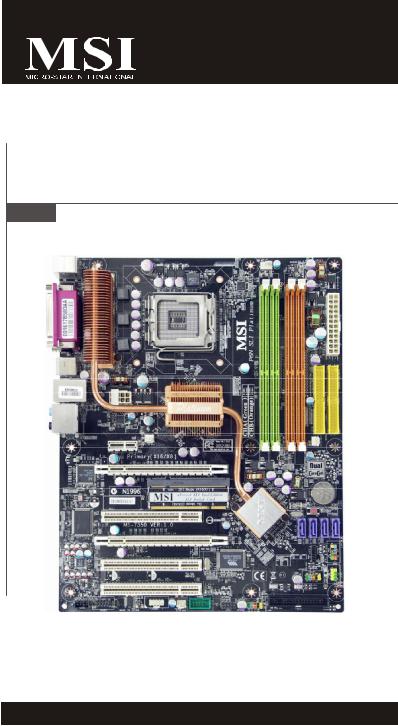
P6N SLI Platinum series
MS-7350 (V1.X) Mainboard
G52-73501X1
i

Copyright Notice
The material in this document is the intellectual property of M ICRO-STAR INTERNATIONAL. We take every care in the preparation of this document, but no guarantee is given as to the correctness of its contents. Our products are under continual improvement and we reserve the right to make changes without notice.
Trademarks
All trademarks are the properties of their respective owners.
NVIDIA, the NVIDIA logo, DualNet, and nForce are registered trademarks or trademarks of NVIDIA Corporation in the United States and/or other countries.
AMD, Athlon™, Athlon™ XP, Thoroughbred™, and Duron™ are registered trademarks of AMD Corporation.
Intel® and Pentium® are registered trademarks of Intel Corporation.
PS/2 and OS®/2 are registered trademarks of International Business Machines Corporation.
Windows® 95/98/2000/NT/XP are registered trademarks of Microsoft Corporation. Netware® is a registered trademark of Novell, Inc.
Award® is a registered trademark of Phoenix Technologies Ltd. AMI® is a registered trademark of American Megatrends Inc.
Revision History
Revision |
Revision History |
Date |
V1.0 |
First release for P6N SLI Platinum |
January 2007 |
Technical Support
If a problem arises with your system and no solution can be obtained from the user’s manual, please contact your place of purchase or local distributor. Alternatively, please try the following help resources for further guidance.
 Visit the MSI website for FAQ, technical guide, BIOS updates, driver updates, and other information: http://www.msi.com.tw/program/service/faq/ faq/esc_faq_list.php
Visit the MSI website for FAQ, technical guide, BIOS updates, driver updates, and other information: http://www.msi.com.tw/program/service/faq/ faq/esc_faq_list.php
 Contact our technical staff at: http://support.msi.com.tw/
Contact our technical staff at: http://support.msi.com.tw/
ii

Safety Instructions
1.Always read the safety instructions carefully.
2.Keep this User’s Manual for future reference.
3.Keep this equipment away from humidity.
4.Lay this equipment on a reliable flat surface before setting it up.
5.The openings on the enclosure are for air convection hence protects the equipment from overheating. DO NOT COVER THE OPENINGS.
6.Make sure the voltage of the power source and adjust properly 110/220V before connecting the equipment to the power inlet.
7.Place the power cord such a way that people can not step on it. Do not place anything over the power cord.
8.Always Unplug the Power Cord before inserting any add-on card or module.
9.All cautions and warnings on the equipment should be noted.
10.Never pour any liquid into the opening that could damage or cause electrical shock.
11.If any of the following situations arises, get the equipment checked by service personnel:
†The power cord or plug is damaged.
†Liquid has penetrated into the equipment.
†The equipment has been exposed to moisture.
†The equipment does not work well or you can not get it work according to User’s Manual.
†The equipment has dropped and damaged.
†The equipment has obvious sign of breakage.
12.DONOT LEAVETHIS EQUIPMENT INANENVIRONMENT UNCONDITIONED, STORAGE TEMPERATURE ABOVE 600 C (1400F), IT MAYDAMAGE THE EQUIPMENT.
CAUTION: Danger of explosion if battery is incorrectly replaced. Replace only with the same or equivalent type recommended by the manufacturer.
iii

FCC-B Radio Frequency Interference Statement
This equipment has been tested and found to comply with the limits for a Class B digital device, pursuant to Part
15 of the FCC Rules. These limits are designed to provide reasonable protection against harmful interference in a residential installation. This equipment generates, uses and can radiate radio frequency energy and, if not installed and used in accordance with the instructions, may cause harmful interference to radio communications. However, there is no guarantee that interference will not occur in a particular installation. If this equipment does cause harmful interference to radio or television reception, which can be determined by turning the equipment off and on, the user is encouraged to try to correct the interference by one or more of the measures listed below.
†Reorient or relocate the receiving antenna.
†Increase the separation between the equipment and receiver.
†Connect the equipment into an outlet on a circuit different from that to which the receiver is connected.
†Consult the dealer or an experienced radio/television technician for help.
Notice 1
The changes or modifications not expressly approved by the party responsible for compliance could void the user’s authority to operate the equipment.
Notice 2
Shielded interface cables and A.C. power cord, if any, must be used in order to comply with the emission limits.
VOIR LANOTICE D’INSTALLATIONAVANT DE RACCORDER AU RESEAU.
Micro-Star International
MS-7350
This device complies with Part 15 of the FCC Rules. Operation is subject to the following two conditions:
(1)this device may not cause harmful interference, and
(2)this device must accept any interference received, including interference that may cause undesired operation.
iv

WEEE (Waste Electrical and Electronic Equipment) Statement
v

vi

vii
|
CONTENTS |
|
Copyright |
Notice .............................................................................................................. |
ii |
Trademarks ....................................................................................................................... |
ii |
|
Revision |
History .............................................................................................................. |
ii |
Technical |
Support ........................................................................................................... |
ii |
Safety Instructions ......................................................................................................... |
iii |
|
FCC-B Radio Frequency Interference Statement ........................................................ |
iv |
|
WEEE (Waste Electrical and Electronic Equipment) Statement .................................... |
v |
|
Chapter 1 Getting Started ..................................................................................... |
1-1 |
|
Mainboard Specifications ................................................................................... |
1-2 |
|
Mainboard Layout ................................................................................................ |
1-4 |
|
Packing Checklist ................................................................................................. |
1-5 |
|
Chapter 2 Hardware Setup ................................................................................... |
2-1 |
|
Quick Components Guide .................................................................................... |
2-2 |
|
CPU (Central Processing Unit) ............................................................................ |
2-3 |
|
Memory................................................................................................................. |
2-7 |
|
Power Supply ...................................................................................................... |
2-9 |
|
Back Panel .......................................................................................................... |
2-12 |
|
Connectors ........................................................................................................ |
2-14 |
|
Button ................................................................................................................. |
2-22 |
|
Slots |
.................................................................................................................... |
2-23 |
Chapter 3 BIOS Setup ............................................................................................. |
3-1 |
|
Entering Setup ..................................................................................................... |
3-2 |
|
The Main Menu ..................................................................................................... |
3-4 |
|
Standard CMOS Features ................................................................................... |
3-6 |
|
Advanced BIOS Features ................................................................................... |
3-9 |
|
Integrated Peripherals ....................................................................................... |
3-12 |
|
Power Management Setup ............................................................................... |
3-15 |
|
PNP/PCI Configurations ..................................................................................... |
3-18 |
|
H/W Monitor ........................................................................................................ |
3-20 |
|
Cell Menu ............................................................................................................ |
3-21 |
|
Load Fail-Safe/ Optimized Defaults ................................................................. |
3-27 |
|
BIOS Setting Password ..................................................................................... |
3-28 |
|
Appendix A Realtek ALC888 Audio .................................................................... |
A-1 |
|
Installing the Realtek Audio Driver ...................................................................... |
A-2 |
|
Software Configuration ...................................................................................... |
A-4 |
|
Hardware Setup ................................................................................................ |
A-19 |
|
viii
Appendix B nVidia RAID ......................................................................................... |
B-1 |
Introduction .......................................................................................................... |
B-2 |
RAID Configuration .............................................................................................. |
B-3 |
NVIDIA RAID Utility Installation ............................................................................. |
B-9 |
RAID Drives Management .................................................................................. |
B-12 |
Appendix C nVidia System Driver ...................................................................... |
C-1 |
nVidia System Driver Installation ........................................................................ |
C-2 |
nVidia Utility Installaion ........................................................................................ |
C-5 |
Appendix D Dual Core Center .............................................................................. |
D-1 |
Activating Dual Core Center ............................................................................... |
D-2 |
Main ...................................................................................................................... |
D-3 |
DOT(Dynamic Over Clocking) ............................................................................. |
D-5 |
Clock ..................................................................................................................... |
D-6 |
Voltage ................................................................................................................. |
D-7 |
FAN Speed ........................................................................................................... |
D-8 |
Temperature ......................................................................................................... |
D-9 |
User Profile ........................................................................................................ |
D-10 |
ix

Getting Started
Chapter 1
Getting Started
Thank you for choosing the P6N SLI Platinum Series (MS-7350 v1.X) ATX mainboard. The P6N SLI Platinum Series mainboards are based on nVidia® nForce 650i SLI chipsets for optimal system efficiency. Designed to fit the advanced Intel® Core 2 Extreme, Core 2
Quad, Core 2 Duo, Pentium XE and Pentium D processor, the P6N SLI Platinum Series deliver a high performance and profess ional desktop platform solution.
1-1
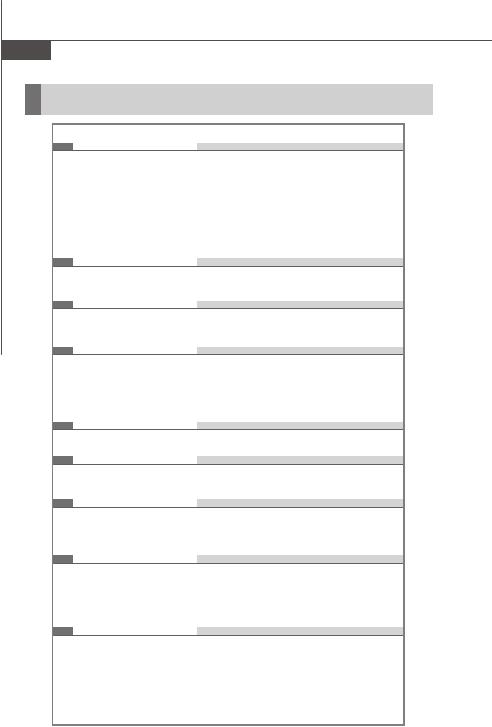
MS-7350 Mainboard
Mainboard Specifications
Processor Support
-Intel® Core 2 Extreme, Core 2 Quad, Core 2 Duo, Pentium XE and Pentium D in the LGA775 package
-Supports Intel® EIST Technology
-Supports Intel® Hyper-Threading (HT) Technology
-Supports Intel® SpeedStep Technology (EIST)
(For the latest information about CPU, please visit http://www.msi. com.tw/program/products/mainboard/mbd/pro_mbd_cpu_support. php)
Supported FSB
- 1333/ 1066/ 800/ 533 MHz (FSB 1333MHz is ready for new Core 2 processors.)
Chipset
-North Bridge: nVidia® nForce 650i SLI (C55)
-South Bridge: nVidia® nForce 430i (MCP51)
Memory Support
-DDR2 533/667/800 SDRAM (240pin, 1.8V)
-4 DDR2 DIMMs (8GB Max)
(For more information on compatible components, please visit http:/ / w w w . m s i . c o m . t w / p r o g r a m / p r o d u c t s / m a i n b o a r d / m b d / pro_mbd_trp_list.php)
LAN
- Supports 10/100/1000 Fast Ethernet by Realtek® RTL8211BL
IEEE 1394
-Chip integrated by VIA VT 6308P
-Transfer rate is up to 400Mbps
Audio
-Chip integrated by Realtek ALC888
-Up to 7.1 Channel audio-out
-Compliant with Azalia 1.0 Spec
IDE
-2 IDE ports by nForce 430i
-Supports Ultra DMA 66/100/133 mode and PIO, Bus Master operation mode
-Supports up to 4 IDE devices
SATA
-4 SATA ports by nForce 430i
-Supports transfer rate up to 300 MB/s
-1 eSATA port by Sil3531 (back panel)
1-2

Getting Started
 RAID
RAID
- SATA1~4 support RAID 0/ 1/ 0+1/ 5 or JBOD mode
Floppy
-1 floppy port
-Supports 1 FDD with 360KB, 720KB, 1.2MB, 1.44MB and 2.88MB
Connectors
 Back panel
Back panel
-1 PS/2 mouse port
-1 PS/2 keyboard port
-1 eSATA port
-1 Parallel port supporting SPP/EPP/ECP mode
-1 IEEE 1394 port
-4 USB 2.0 ports
-1 LAN jack
-5 flexible audio jacks
-1 Optical SPDIF-Out port / 1 Coaxial SPDIF-out port
 On-Board Pinheaders
On-Board Pinheaders
-1 D-Bracket 2 pinheader
-1 Chassis Intrusion pinheader
-2 USB 2.0 pinheaders
-1 IEEE 1394 pinheader
-1 SPDIF-out pinheader (for HDMI only)
-1 serial port
-1 CD-in connector
-1 front panel audio pinheader
Slots
-2 PCI Express x16 slots
a.the second PCI Express x 16 slot (PCI_E4) is a special design that supports PCI Express x 8 mode only
b.these two slots can support SLI technology with PCIE x8 mode
c.the second PCI Express x 16 slot (PCI_E4) only supports to install
graphics card in SLI mode
-1 PCI Express x1 slot
-3 PCI slots, support 3.3V/ 5V PCI bus Interface
Form Factor
- ATX (30.5 cm X 24.5 cm)
Mounting
- 9 mounting holes
1-3
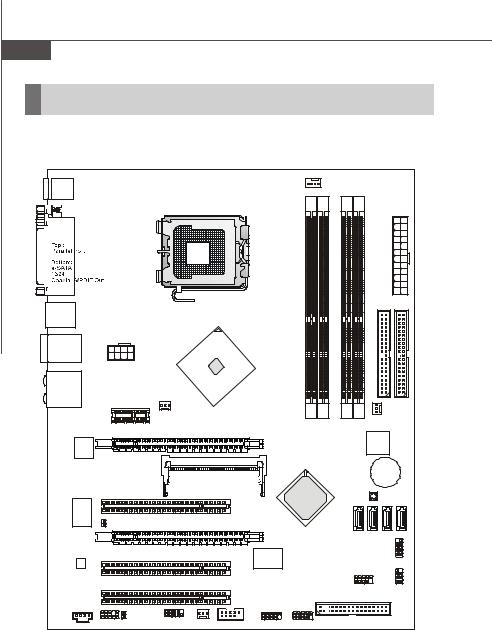
MS-7350 Mainboard |
|
|
|
|
|
|
|
||
Mainboard Layout |
|
|
|
|
|
|
|
||
|
|
|
|
|
CPUFAN1 |
|
|
|
|
Top : mouse |
|
|
|
|
|
|
|
|
|
Bottom: keyboard |
|
|
|
|
|
|
|
|
|
|
|
|
|
|
|
|
|
ATX1 |
|
USB ports |
|
|
|
|
|
|
|
|
|
T: LAN |
|
|
Nvidia |
|
|
|
|
|
|
B: USB ports |
|
|
Nforce 650I SLI |
|
|
|
|
|
|
|
JPW1 |
|
|
|
|
|
|
|
|
T:Line-In |
|
|
|
|
|
|
|
|
|
M:Line-Out |
|
|
|
|
|
|
|
|
|
B:Mic |
|
|
|
|
|
|
|
|
|
T:RS-Out |
|
|
|
|
|
|
|
|
|
M:CS-Out |
|
|
|
|
|
|
|
IDE2 |
IDE1 |
B:Optical |
|
|
|
|
|
|
|
||
S/PDIF Out |
|
SYSFAN1 |
|
|
|
|
|
||
|
|
|
|
|
|
SYSFAN3 |
|||
|
|
|
|
|
|
|
|||
|
PCI_E1 |
|
|
DIMM1 DIMM3 |
DIMM2 |
DIMM4 |
|
|
|
|
|
|
|
|
|
|
|||
LAN Chip |
|
|
|
|
|
|
|
|
|
|
PCI_E2 |
|
|
|
|
|
|
|
|
|
|
|
PCI_E3 |
|
|
|
|
BATT |
|
|
|
|
|
|
|
|
+ |
|
|
|
PCI1 |
|
|
Nvidia |
|
SW1 |
|
|
|
|
|
|
|
|
Nforce 430I |
|
|
|
|
I/O |
|
|
|
|
|
|
|
|
|
Chip |
|
|
|
|
|
SATA1 |
|
|
|
|
JCI1 |
PCI_E4 |
|
|
|
SATA2 |
|
SATA4 |
|
|
|
|
|
|
|
SATA3 |
|||
Codec |
PCI2 |
|
1394 |
|
|
|
|
JFP1 |
|
|
|
|
|
Chip |
|
|
|
|
|
|
PCI3 |
|
|
|
|
JUSB2 |
|
JFP2 |
|
|
|
|
|
|
|
|
|
||
|
|
SPDO1 |
|
|
FDD1 |
|
|
|
|
|
JAUD1 |
JCOM1 |
SYSFAN2 J1394_1 |
JDB1 |
|
|
|
|
|
JCD1 |
JUSB1 |
|
|
|
|
||||
|
|
|
|
|
|||||
P6N SLI Platinum Series (MS-7350 v1.X) ATX Mainboard
1-4
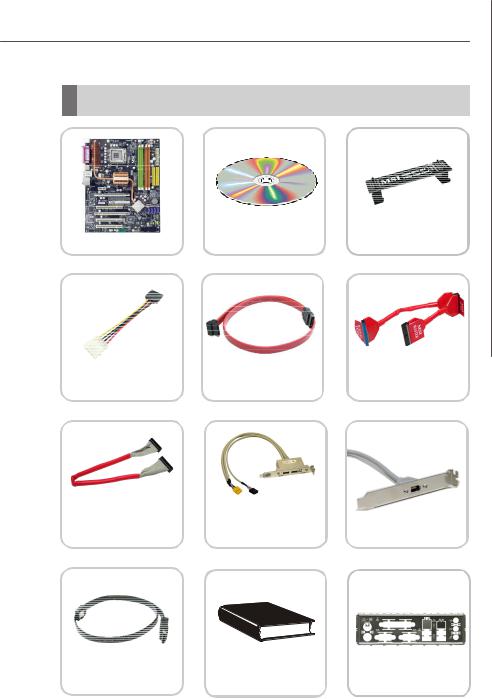
Getting Started
Packing Checklist
MSI motherboard |
MSI Driver/Utility CD |
SLI Video Link Card |
|
|
Power Cable |
SATA Cable |
Round Cable of |
|
IDE Devices |
|||
|
|
Round Cable of |
D-Bracket 2 (Optional) |
1394 Bracket (Optional) |
|
Floppy Disk (Optional) |
|||
|
|
external SATA Cable |
User’s Guide |
Back IO Shield |
|
(Optional) |
|||
|
|
* The pictures are for reference only and may vary from the packing contents of the product you purchased.
1-5
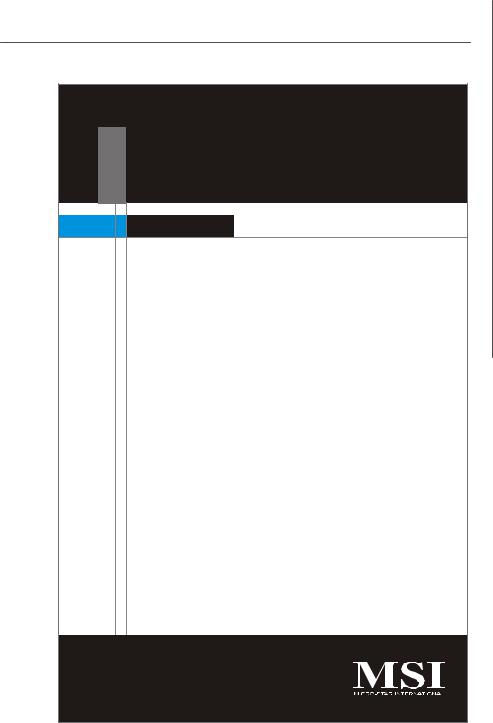
Hardware Setup
Chapter 2
Hardware Setup
This chapter provides you with the information about hardware setup procedures. While doing the installation, be careful in holding the components and follow the installation procedures. For some components, if you install in the wrong orientation, the components will not work properly.
Use a grounded wrist strap before handling computer components. Static elec tric ity may damage the components.
2-1
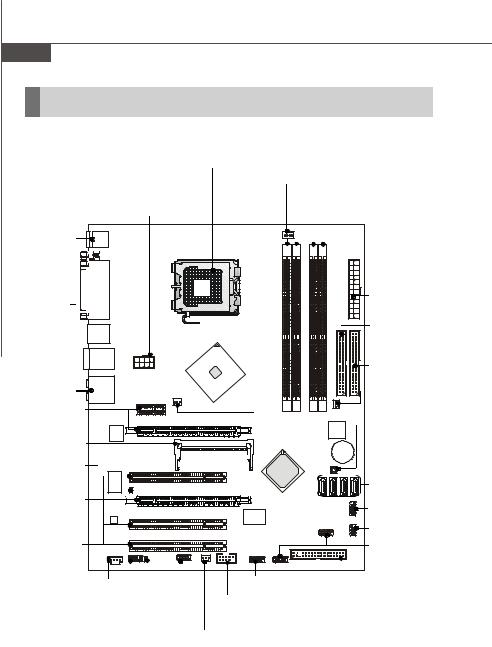
MS-7350 Mainboard
Quick Components Guide
|
|
CPU, p.2-3 |
|
|
|
|
|
CPUFAN, p.2-16 |
|
|
|
|
SYSFAN1, |
DDRII DIMMs, p.2-6 |
|
JPW1, p.2-10 |
|
p.2-16 |
|
|
|
|
||
Back Panel |
|
|
|
ATX1, p.2-10 |
I/O, p.2-12 |
|
|
|
|
|
|
|
|
IDE2, p.2-14 |
|
|
|
|
IDE1, p.2-14 |
|
|
|
|
SYSFAN3, |
PCI Express |
|
|
|
p.2-16 |
|
|
|
|
|
slots, p.2-23 |
|
|
|
SW1, p.2-22 |
|
|
|
|
|
NV SLI conn., |
|
|
|
|
p.2-23 |
|
|
|
|
JCI1, p.2-16 |
|
|
|
|
|
|
|
|
SATA1~4, |
PCI Express |
|
|
|
p.2-15 |
|
|
|
|
|
slots, p.2-23 |
|
|
|
JFP1, p.2-20 |
|
|
|
|
|
|
|
|
|
JFP2, p.2-20 |
PCI Slots, |
|
|
|
JUSB1~2, |
p.2-27 |
|
|
|
p.2-18 |
JCD1, p.2-16 |
JCOM1, |
JDB1, p.2-21 |
FDD1, p.2-14 |
|
|
|
|||
|
p.2-17 |
|
J1394_1~2, p.2-19 |
|
|
|
|
|
|
SPDO1,
p.2-19 SYSFAN2, p.2-16
JAUD1, p.2-17
2-2
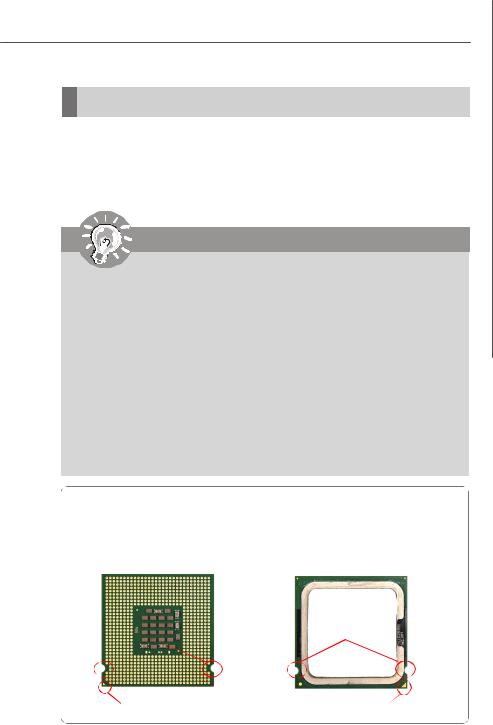
Hardware Setup
CPU (Central Processing Unit)
This mainboard supports Intel® Core 2 Extreme, Core 2 Quad, Core 2 Duo, Pentium XE and Pentium D processor in LGA 775 package. When you are installing the CPU, make sure to install the cooler to prevent overheating. If you do not have the CPU cooler, consult your dealer before turning on the computer. For the latest information about CPU, please visit http://www.msi.com.tw/program/products/mainboard/ mbd/pro_mbd_cpu_support.php
Important
Overheating
Overheating will seriously damage the CPU and system. Always make sure the cooling fan can work properly to protect the CPU from overheating. Make sure that you apply an even layer of thermal paste (or thermal tape) between the CPU and the heatsink to enhance heat dissipation.
Replaceing the CPU
While replacing the CPU, always turn off the ATX power supply or unplug the power supply’s power cord from the grounded outlet first to ensure the safety of CPU.
Overclocking
This mainboard is designed to support overclocking. However, please make sure your components are able to tolerate such abnormal setting, while doing overclocking. Any attempt to operate beyond product specifications is not recommended. We do not guarantee the damages or risks caused by inadequate operation or beyond product specifications.
Introduction to LGA 775 CPU
The pin-pad side of LGA 775 CPU.
The surface of LGA 775 CPU. Remember to apply some thermal paste on it for better heat dispersion.
Alignment Key |
Alignment Key |
Yellow triangle is the Pin 1 indicator |
Yellow triangle is the Pin 1 indicator |
|
2-3
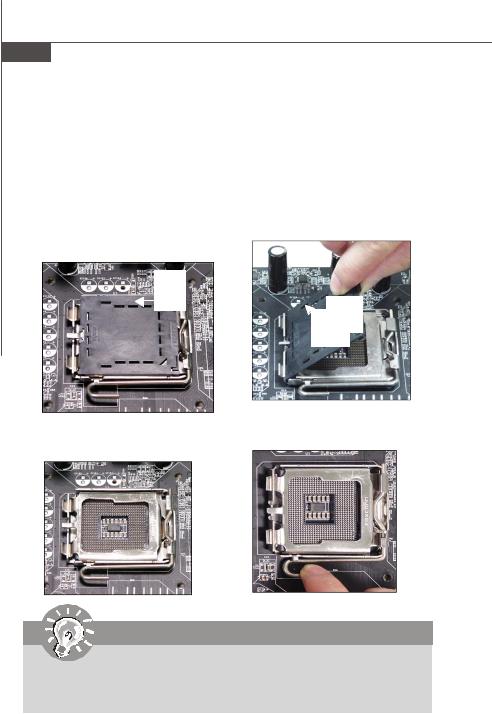
MS-7350 Mainboard
CPU & Cooler Installation
When you are installing the CPU, make sure the CPU has a cooler attached on the top to prevent overheating. Meanwhile, do not forget to apply some thermal paste on CPU before installing the heat sink/cooler fan for better heat dispersion.
Follow the steps below to install the CPU & cooler correctly. Wrong installation will cause the damage of your CPU & mainboard.
1.The CPU socket has a plastic cap on it to protect the contact from damage. Before you install the CPU, always cover it to protect the socket pin.
2.Remove the cap from lever hinge side (as the arrow shows).
4. Open the load lever.
3. The pins of socket reveal.
Important
1.Confirm if your CPU cooler is firmly installed before turning on your system.
2.Do not touch the CPU socket pins to avoid damaging.
3.The availability of the CPU land side cover depends on your CPU packing.
2-4

5.Lift the load lever up and open the load plate.
Hardware Setup
6.After confirming the CPU direction for correct mating, put down the CPU in the socket housing frame. Be sure to grasp on the edge of the CPU base. Note that the alignment keys are matched.
alignment key
7.Visually inspect if the CPU is seated well into the socket. If not, take out the CPU with pure vertical motion and reinstall.
8.Cover the load plate onto the package.
2-5
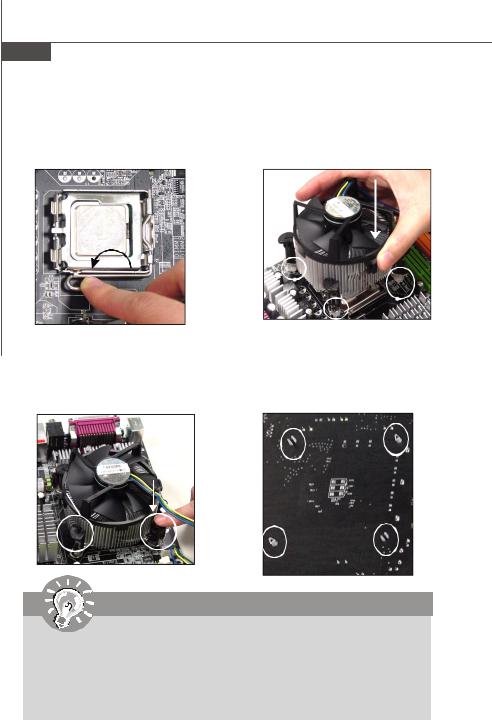
MS-7350 Mainboard
9.Press down the load lever lightly onto the load plate, and then secure the lever with the hook under retention tab.
11.Press the four hooks down to fasten the cooler. Then rotate the locking switch (refer to the correct direction marked on it) to lock the hooks.
locking switch
10.Align the holes on the mainboard with the heatsink. Push down the cooler until its four c lips get wedged into the holes of the mainboard.
12.Turn over the mainboard to confirm that the clip-ends are correctly inserted.
Important
1.Read the CPU status in BIOS (Chapter 3).
2.Whenever CPU is not installed, always protect your CPU socket pin with the plastic cap covered (shown in Figure 1) to avoid damaging.
3.Mainboard photos shown in this section are for demonstration of the CPU/ cooler installation only. The appearance of your mainboard may vary depending on the model you purchase.
2-6

Hardware Setup
Memory
These DIMM slots are used for installing memory modules.
For more information on compatible components, please visit http://www.msi.com.tw/ program/products/mainboard/mbd/pro_mbd_trp_list.php
DDR2
240-pin, 1.8V
56x2=112 pin |
64x2=128 pin |
Dual-Channel Memory Population Rules
In Dual-Channel mode, the memory modules can transmit and receive data with two data bus lines simultaneously. Enabling Dual-Channel mode can enhance the system performance. Please refer to the following illustrations for population rules under Dual-Channel mode.
1 |
DIMM1 |
|
|
|
DIMM3 |
|
DIMM2 |
|
DIMM4 |
2 |
DIMM1 |
|
DIMM3 |
|
DIMM2 |
|
DIMM4 |
3 |
DIMM1 |
|
DIMM3 |
|
DIMM2 |
|
DIMM4 |










































 Installed
Installed
Empty
2-7
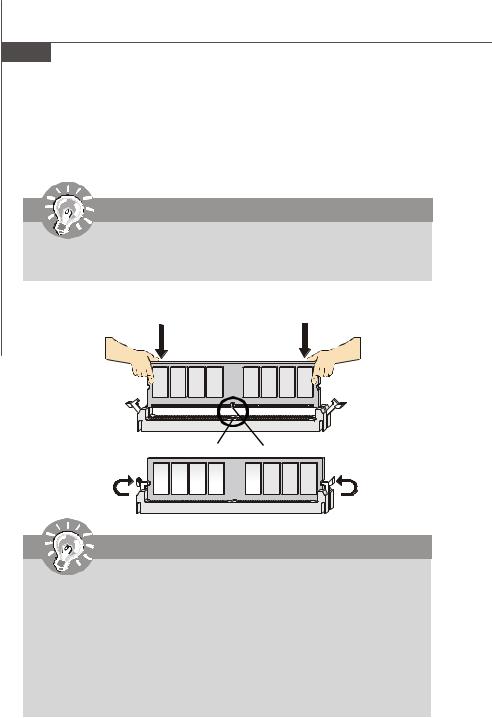
MS-7350 Mainboard
Installing DDR2 Modules
1.The memory module has only one notch on the center and will only fit in the right orientation.
2.Insert the memory module vertically into the DIMM slot. Then push it in until the golden finger on the memory module is deeply inserted in the DIMM slot.
Important
You can barely see the golden finger if the module is properly inserted in the DIMM slot.
3. The plastic clip at each side of the DIMM slot will automatically close.
Volt Notch
Important
-DDR2 memory modules are not interchangeable with DDR and the DDR2 standard is not backwards compatible. You should always install DDR2 memory modules in the DDR2 DIMM slots.
-In Dual-Channel mode, make sure that you install memory modules of the same type and density in different channel DIMM slots.
-To enable successful system boot-up, always insert the memory modules into the DIMM1 first.
-Due to the chipset resource deployment, the system density will only be detected up to 7+GB (not full 16GB) when each DIMM is installed with a 2GB memory module.
2-8

Hardware Setup
If you intend to install the DDR2 800 memory modules into the DIMM slots of the mainboard, we recommend that you to use the available memory modules as below.
|
|
|
|
Memory Slot |
|
Memory |
|
|
|
Model |
Size |
1 |
2 |
3 |
4 |
Bandwidth |
R.S.T |
TwinMOS |
TwiSTER Series 8G24IK-TW |
256MB |
V |
|
|
|
OK |
OK |
# |
|
|
V |
|
V |
|
OK |
OK |
|
|
|
V |
V |
V |
V |
OK |
OK |
A-DATA |
Vitesta(M20AD6G3H3160I1E53) |
512MB |
V |
|
|
|
OK |
OK |
|
|
|
V |
|
V |
|
OK |
OK |
|
|
|
V |
V |
V |
V |
OK |
OK |
GEIL |
GX21GB6400DC |
512MB |
V |
|
|
|
OK |
OK |
|
|
|
V |
|
V |
|
OK |
OK |
HYNIX |
HYMP564U64BP8-S5 AB |
512MB |
V |
|
|
|
OK |
OK |
|
(HYNIX HY5PS12821BFP-S5) |
|
V |
|
V |
|
OK |
OK |
|
|
|
V |
V |
V |
V |
OK |
OK |
Infineon |
HYS64T64000HU-3S-B |
512MB |
V |
|
|
|
OK |
OK |
|
(Infineon HYB18T512800BF3S) |
|
V |
|
V |
|
OK |
OK |
|
|
|
V |
V |
V |
|
OK |
OK |
Kingston |
KVR800D2N5/512 |
512MB |
V |
|
|
|
OK |
OK |
|
(SEC K4T51083QC ES) |
|
V |
|
V |
|
OK |
OK |
|
|
|
V |
V |
V |
V |
OK |
OK |
PQI |
MEAE-303HA |
512MB |
V |
|
|
|
OK |
OK |
|
(ELPIDA E2508AB-GE-E) |
|
V |
|
V |
|
OK |
OK |
|
|
|
|
|
||||
|
|
|
V |
V |
V |
V |
OK |
OK |
ProMOS |
V916764K24QBFW-G5 |
512MB |
V |
|
|
|
OK |
OK |
|
(ProMOS V59C1512804QBF25) |
|
V |
|
V |
|
OK |
OK |
|
|
|
V |
V |
V |
V |
OK |
OK |
Transcend |
VB(SEC K4T51083QC) |
512MB |
V |
|
|
|
OK |
OK |
|
|
|
V |
|
V |
|
OK |
OK |
|
|
|
V |
V |
V |
V |
OK |
OK |
Transcend |
[VB](HYNIX HY5PS12812B) |
512MB |
V |
|
|
|
OK |
OK |
|
|
|
V |
|
V |
|
OK |
OK |
|
|
|
V |
V |
V |
V |
OK |
OK |
Apacer |
78.01G9I.AUC |
1GB |
V |
|
|
|
OK |
OK |
|
(Apacer AM4B5708BHJS8E) |
|
V |
|
V |
|
OK |
OK |
GEIL |
GX22GB6400DC |
1GB |
V |
|
|
|
OK |
OK |
|
|
|
V |
|
V |
|
OK |
OK |
|
|
|
V |
V |
V |
V |
OK |
OK |
HYNIX |
HYMP512U64BP8-S5 AB |
1GB |
V |
|
|
|
OK |
OK |
|
(HYNIX HY5PS12821BFP-S5) |
|
V |
|
V |
|
OK |
OK |
KingBox |
|
1GB |
V |
|
|
|
OK |
OK |
|
(KINGBOX EPR264082200-3) |
|
V |
|
V |
|
OK |
OK |
|
|
|
V |
V |
V |
|
OK |
OK |
Transcend |
VQ(SEC K4T51083QC) |
1GB |
V |
|
|
|
OK |
OK |
|
|
|
V |
|
V |
|
OK |
OK |
Kingston |
HYPER(KHX6400D2LLK2/2G) |
1GB |
V |
|
|
|
OK |
OK |
|
|
|
V |
|
V |
|
OK |
OK |
|
|
|
V |
V |
V |
V |
OK |
OK |
AENEON |
AET760UD00-25DB97X |
1GB |
V |
|
|
|
OK |
OK |
|
(AENEON AET93R250) |
|
|
|
|
|||
|
|
V |
|
V |
|
OK |
OK |
|
|
|
|
V |
V |
V |
V |
OK |
OK |
2-9
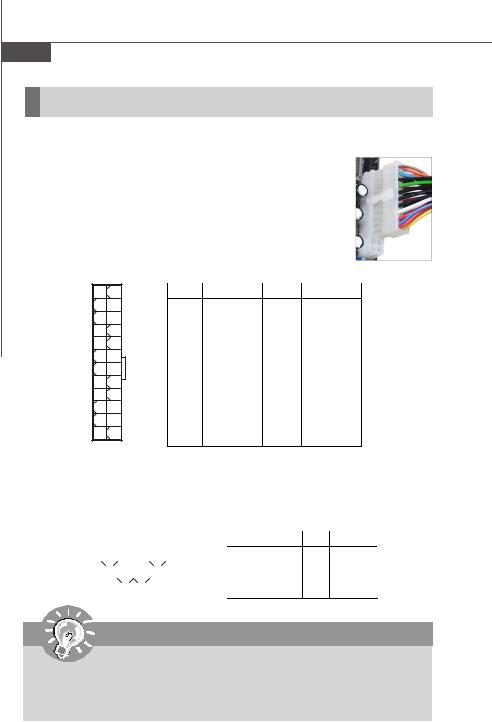
MS-7350 Mainboard
Power Supply
ATX 24-Pin Power Connector: ATX1
This connector allows you to connect an ATX 24-pin power supply. To connect the ATX 24-pin power supply, make sure the plug of the power supply is inserted in the proper orientation and the pins are aligned. Then push down the power supply firmly into the connector.
You may use the 20-pin ATX power supply as you like. If you’d like to use the 20-pin ATX power supply, please plug your power supply along with pin 1 & pin 13 (refer to the image at the right hand). There is also a foolproof design on pin 11, 12, 23 & 24 to avoid wrong installation.
Pin Definition
12 |
24 |
ATX1 |
|
1 |
13 |
PIN |
SIGNAL |
PIN |
SIGNAL |
1 |
+3.3V |
13 |
+3.3V |
2 |
+3.3V |
14 |
-12V |
3 |
GND |
15 |
GND |
4 |
+5V |
16 |
PS-ON# |
5 |
GND |
17 |
GND |
6 |
+5V |
18 |
GND |
7 |
GND |
19 |
GND |
8 |
PWROK |
20 |
Res |
9 |
5VSB |
21 |
+5V |
10 |
+12V |
22 |
+5V |
11 |
+12V |
23 |
+5V |
12 |
+3.3V |
24 |
GND |
 pin 13
pin 13
 pin 12
pin 12
ATX 12V Power Connector: JPW1
This power connector is used to provide power to the CPU.
|
JPW1 |
|
Pin Definition |
|
|||||||
8 |
|
|
|
|
|
|
5 |
PIN |
SIGNAL |
PIN |
SIGNAL |
|
|
|
|
|
|
|
|
1 |
GND |
5 |
+12V |
|
|
|
|
|
|
|
|
2 |
GND |
6 |
+12V |
|
|
|
|
|
|
|
|
||||
|
|
|
|
|
|
|
|
3 |
GND |
7 |
+12V |
|
|
|
|
|
|
|
|
|
|
|
|
4 |
1 |
4 |
GND |
8 |
+12V |
||||||
Important
1.Make sure that all the connectors are connected to proper ATX power supplies to ensure stable operation of the mainboard.
2.Power supply of 450 watts (and above) is highly recommended for system stability.
2-10
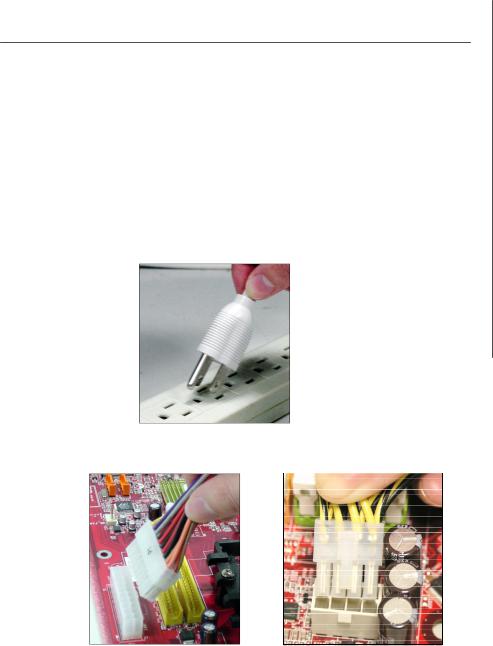
Hardware Setup
Important Notification about Power Issue
NForce chipset is very sensitive to ESD (Electrostatic Discharge), therefore this issue mostly happens while the users intensively swap memory modules under S5 (power-off) states, and the power code is plugged while installing modules. Due to several pins are very sensitive to ESD, so this kind of memory-replacement actions might cause system chipset unable to boot. Please follow the following solution to avoid this situation.
Unplug the AC power cable (shown in figure 1) or unplug the power connectors (shown in figure 2 & figure 3) before the 1st installation or during system upgrade procedure.
Figure 1:
Unplug the AC power cable
Figure 2: |
Figure 3: |
Unplug the power connector |
Unplug the power connectors |
2-11
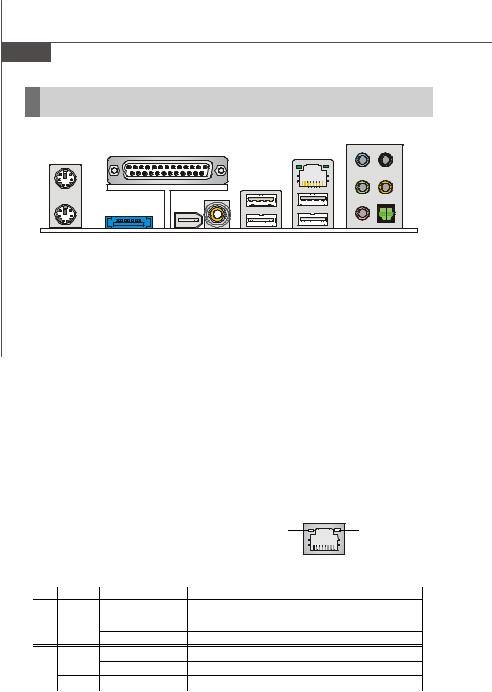
MS-7350 Mainboard
Back Panel
Parallel Port |
LAN |
|
|
Mouse |
|
|
|
|
USB Port |
|
Line-In RS-Out |
|
|
|
|
|
|
|
Line-Out CS-Out |
Keyboard eSATA Port |
1394 Coaxial |
USB Port |
Mic Optical |
|
Port S/PDIF-Out |
|
S/PDIF-Out |
 Mouse/Keyboard
Mouse/Keyboard
The standard PS/2® mouse/keyboard DIN connector is for a PS/2® mouse/keyboard.
 Parallel Port
Parallel Port
A parallel port is a standard printer port that supports Enhanced Parallel Port (EPP) and Extended Capabilities Parallel Port (ECP) mode.
 eSATA Port
eSATA Port
This eSATA (External Serial ATA) port is used to connect the external SATA device. You can also use the optional external SATA cable to connect SATA device and eSATA port.
 1394 Port
1394 Port
The IEEE1394 port on the back panel provides connection to IEEE1394 devices.
 Coaxial S/PDIF-Out
Coaxial S/PDIF-Out
This SPDIF (Sony & Philips Digital Interconnect Format) connector is provided for digital audio transmission to external speakers through a coaxial cable.
 LAN
LAN
The standard RJ-45 LAN jack is for connection to the Local Area Network (LAN). You can connect a network cable to it.
ActivityIndicator |
LinkIndicator |
LED |
Color |
LED State |
condition |
|
|
Off |
LAN link is not established. |
Left |
Orange |
On (steady state) |
LAN link is established. |
|
|
On (brighter & pulsing) The computeris communicating with another computer on the LAN. |
|
|
Green |
Off |
10 Mbit/sec data rate is selected. |
Right |
|
On |
100 Mbit/sec data rate is selected. |
|
Orange |
On |
1000 Mbit/sec data rate is selected. |
2-12
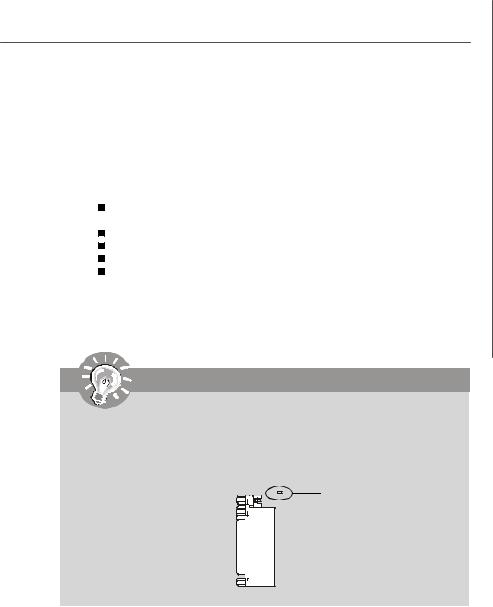
Hardware Setup
 USB Port
USB Port
The USB (Universal Serial Bus) port is for attaching USB devices such as keyboard, mouse, or other USB-compatible devices.
 Audio Ports
Audio Ports
These audio connectors are used for audio devices. You can differentiate the color of the audio jacks for different audio sound effects.
Line-In (Blue) - Line In / Side-Surround Out in 7.1 channel mode, is used for external CD player, tapeplayer or other audio devices.
Line-Out (Green) - Line Out, is a connector for speakers or headphones.
Mic (Pink) - Mic, is a connector for microphones.
RS-Out (Black) - Rear-Surround Out in 4/ 5.1/ 7.1 channel mode. CS-Out (Orange) - Center/ Subwoofer Out in 5.1/ 7.1 channel mode.
 Optical S/PDIF-Out
Optical S/PDIF-Out
This SPDIF (Sony & Philips Digital Interconnect Format) connector is provided for digital audio transmission to external speakers through an optical fiber cable.
Important
1.Use only one of the three types of S/PDIF-out, coaxial S/PDIF-out, optical S/PDIF-out, or onboard 2-pin S/PDIF-out connector for HDMI graphics card, otherwise the audio transmission will be distorted.
2.The indicator LED beside the e-SATA connector and will shine blue light when the connector is connected.
Indicator LED |
2-13

MS-7350 Mainboard
Connectors
Floppy Disk Drive Connector: FDD1
This connector supports 360KB, 720KB, 1.2MB, 1.44MB or 2.88MB floppy disk drive.
FDD1
IDE Connector: IDE1 / IDE2
This connector supports IDE hard disk drives, optical disk drives and other IDE devices.
IDE2 IDE1
IDE1 (Primary IDE Connector)
The first hard drive should always be connected to IDE1. IDE1 can connect a Master and a Slave drive.
IDE2 (Secondary IDE Connector)
IDE2 can also connect a Master and a Slave drive.
Important
If you install two IDE devices on the same cable, you must configure the drives separately to master / slave mode by setting jumpers. Refer to IDE device’ s documentation supplied by the vendors for jumper setting instructions.
2-14
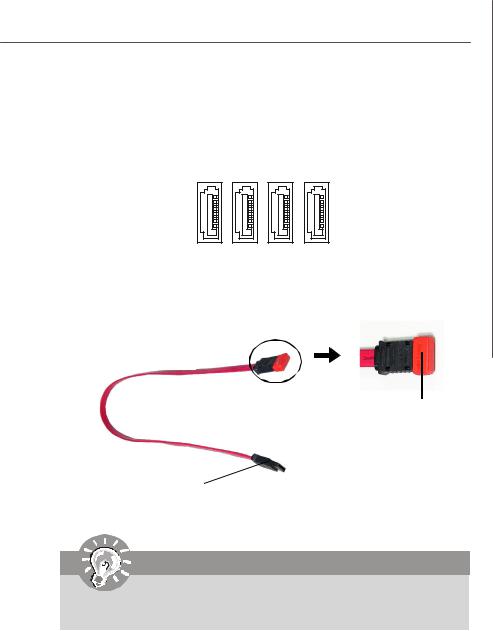
Hardware Setup
Serial ATA Connector: SATA1/ SATA2/ SATA3/ SATA4
This connector is a high-speed Serial ATA interface port. Each connector can connect to one Serial ATA device.
SATA2 SATA4
SATA1 SATA3
Serial ATA cable
Take out the dust cover and connect to the hard disk devices
Connect to SATA connector
Important
Please do not fold the Serial ATA cable into 90-degree angle. Otherwise, data loss may occur during transmission.
2-15

MS-7350 Mainboard
Fan Power Connectors: CPUFAN, SYSFAN1, SYSFAN2, SYSFAN3
The fan power connectors support system cooling fan with +12V. When connecting the wire to the connectors, always note that the red wire is the positive and should be connected to the +12V; the black wire is Ground and should be connected to GND. If the mainboard has a System Hardware Monitor chipset on-board, you must use a specially designed fan with speed sensor to take advantage of the CPU fan control.
SENSOR +12V |
|
+12V |
|
+12V |
|
|
|
|
|
GND |
SENSOR |
GND |
SENSOR |
NC |
|
|
|
|
|
|
|
|||||
Control |
GND |
|
|
|
+12V |
|
|
|
|
|
|
GND |
|
|
|
||
|
|
|
|
|
|
|
|
|
CPUFAN |
SYSFAN1 |
SYSFAN2 |
SYSFAN3 |
|||||
Important
1.Please refer to the recommended CPU fans at processor’s official website or consult the vendors for proper CPU cooling fan.
2.CPUFAN supports fan control. You can install Dual Core Center utility that will automatically control the CPU fan speed according to the actual CPU temperature.
3.Fan/heatsink with 3 or 4 pins are both available for CPUFAN.
Chassis Intrusion Connector: JCI1
This connector connects to the chassis intrusion switch cable. If the chassis is opened, the chassis intrusion mechanism will be activated. The system will record this status and show a warning message on the screen. To clear the warning, you must enter the BIOS utility and clear the record.
1  CINTRU
CINTRU
2 
 GND
GND
JCI1
CD-In Connector: JCD1
This connector is provided for external audio input.
GND
L
 R
R
JCD1
2-16
